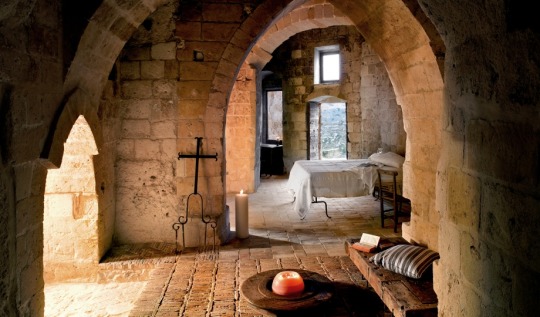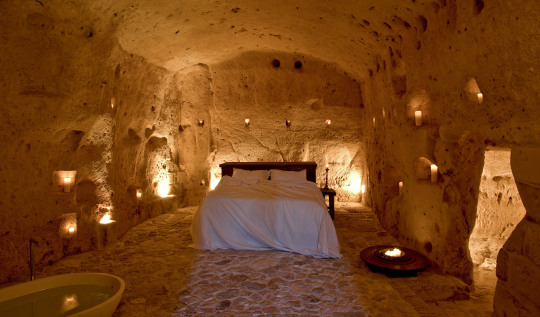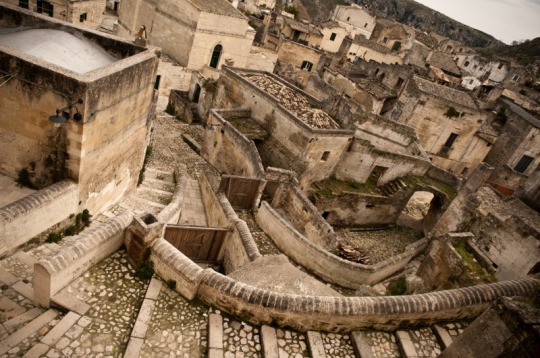For as much as I have traveled in Italy, I haven’t yet been further south than the Amalfi Coast. Not because I don’t want to, but up till now the famous cathedrals, shiny tourist attractions, romantic canals, quaint country beauty and well-chronicled history of many areas in central and northern Italy have called me to them in a more immediate way. More recently, though, I’ve heard another call. More like a whisper, really. The soft, mysterious invitation of the caves of Matera.
The caves – or sassi, as they’re called locally – date back to Prehistoric times. For over 9000 years, according to some experts, Matera’s caverns have been inhabited, right up until the 1950′s when the Italian government forced the remaining families out of the caves and into an ill-conceived pre-fab housing project on top of the plateau. At that time, many areas of southern Italy had been criticized for their poverty, entire families living in a one-room cave with their animals in squalor. Malaria was a problem because of the over-crowded and unclean living arrangements. It was a national scandal; one that the Italian government acted to correct.
By the 1980′s, though, the caves were no longer a symbol of poverty but of a fascinating and enduring history. In the late ‘80′s, several citizens took it upon themselves to begin renovating the old caves, installing electricity, heat and plumbing. In 1993, Matera was declared a UNESCO World Heritage Site for being “the most outstanding, intact example of a troglodyte settlement in the Mediterranean region, perfectly adapted to its terrain and ecosystem.” Soon after that, the first cave hotels opened and now over 3000 residents have moved back into this historic neighborhood from the plateau above.
Hotels and homes in ancient caves aren’t the only things in Matera, though they might be enough to put it on my “To-Do” list all by themselves. I’ve listed 6 reasons below why Matera will be one of my next stops on my travels through this beautiful country. Have you been to Matera? What did you think?

(Photo courtesy Vanity Fair)
1) Stay overnight (or overnightS!) in a cave.
As previously mentioned, some of Matera’s residents and now outside admirers of the region have renovated the Prehistoric caves and turned them into incredible, mystical hotels. Sextantio delle Grotte della Civita, two of its rooms pictures below, is one of those hotels and, as you can see, some of the rooms look out the side of the plateau to the valley below. I’d probably opt for one of the more true “cave” rooms, though!


2) Tour a cave reconstruction.
Several caves in the sassi of Matera have been reconstructed to show how families lived in them for thousands of years before the 1950′s. Period furnishings and audio explanations in several languages help the visitor to understand what life was like in these crowded, poor conditions. Two cave reconstructions of note are the Casa Grotta di Vico Solitario in the Sasso Caveoso area and Casa Grotta del Barisano in Sasso Barisano.
3) Worship in the Chiese Rupestri
Churches have been cut into the rock around Matera for hundreds of years and have come to be known as chiese rupestri. Most of them were built by Byzantine priests fleeing persecution in the 800′s and 900′s and many have faded frescoes on their walls in the Byzantine style. Some are closed to the public and others are able to be accessed only on a tour, but the tourist office sells a combined ticket to visit a handful of the chiese rupestri on your own.
4) Walk through the giant cistern under Piazza Vittorio Veneto
In medieval times large-scale works were carried out to carve large cisterns into the rock to catch rain water for the town. The largest of these is under the popular Piazza Vittorio Veneto and can be toured for only a few euro. On short, guided tours visitors are led over metal walkways into the immense cavern where the ceilings are 15 meters overhead.
5) Admire the frescoes in “The Crypt of Original Sin”
“The Crypt of Original Sin”, also known as the “Sistine Chapel” of Rupestrian art, is just a few kilometers from Matera, carved into one of the many local ravines. Originally created in the 900′s by an individual now only known as the “Painter of the Flowers of Matera”, the frescoes relate scenes from both the Old and New Testaments.
6) Get social with the locals in Piazza Vittorio Veneto
Matera’s liveliest square is Piazza Vittorio Veneto. Head here on an afternoon to explore the shops and artisan booths or to have your portrait painted. In the evening, discover local night life with a drink at one of the bars lining the square.
6) Ignore daylight in underground spas, bars and restaurants
Or, if you prefer something a bit more exotic, try one of Matera’s underground restaurants, bars, cafés or spas! Many of the caves in the sassi have been converted to delight and intrigue visitors and locals alike. I think this is where you’ll find me ![]()

(Photo courtesy Il Cantuccio Matera)
(Cover photo courtesy Wiki Commons)
Comments
comments










Leave a Reply